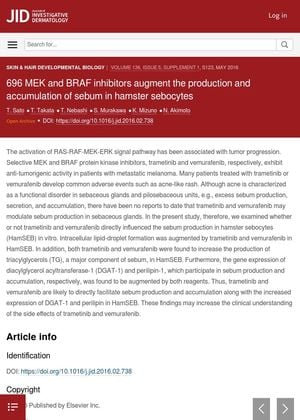MEK and BRAF Inhibitors Augment the Production and Accumulation of Sebum in Hamster Sebocytes
April 2016
in “
Journal of Investigative Dermatology
”

TLDR MEK and BRAF inhibitors increase sebum production and accumulation, which could cause acne-like side effects.
In 2016, a study was conducted to examine the effects of MEK and BRAF protein kinase inhibitors, trametinib and vemurafenib, on sebum production in hamster sebocytes (HamSEB) in vitro. These inhibitors are known for their anti-tumorigenic activity in patients with metastatic melanoma, but often cause adverse events like acne-like rash. The study found that both trametinib and vemurafenib increased intracellular lipid-droplet formation and the production of triacylglycerols (TG), a major component of sebum, in HamSEB. They also increased the gene expression of diacylglycerol acyltransferase-1 (DGAT-1) and perilipin-1, which are involved in sebum production and accumulation. Therefore, the study concluded that trametinib and vemurafenib likely directly facilitate sebum production and accumulation, which could explain the acne-like side effects observed in patients.

